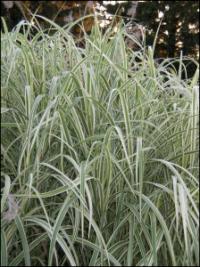Description
Vertical white srtipes on 4′ arching green grass blades, inflorescenses coppery russet in fall
Vertical white srtipes on 4′ arching green grass blades, inflorescenses coppery russet in fall,
Vertical white srtipes on 4′ arching green grass blades, inflorescenses coppery russet in fall
Balloon shaped buds opening to white bells in mid-summer to early fall.
Size: 24" x 12"
Care: Full sun to part shade in moist well-drained soil. Heat and drought tolerant. Deadhead for rebloom.
Native: Eastern Asia
Wildlife Value: attracts hummingbirds, bees & butterflies
Awards: England's Royal Horticultural Society Award of Garden Merit.
Platycodon is Greek from platys meaning “broad” and kodon meaning “bell”, referring to the shape of the flower. Cultivated in China for hundreds of years where it is called Jie-geng. Chinese used the root boiled to cure a chill in the stomach. Mentioned in Man’yoshu, a Japanese anthology of poems written in the 8th century. German botanist Johann Gmelin (1709-1755) collected P. grandiflorus in Siberia in 1754. Gmelin’s Siberian mission, sponsored by Catherine the Great, took 10 years and nearly killed him. Gmelin introduced it to European garden cultivation by 1782. Robert Fortune found the white form in a nursery near Shanghai and sent it to England in 1845.
Powder-blue flowers of terminal clusters in early summer; feathery, thin,”threadleaf” foliage turns caution-sign yellow in fall.
Size: 2-3’ x 2-3’
Care: sun to part shade in moist well-drained soil
Native: Central-So, US
Wildlife Value: attracts butterflies & bees
Awards: Plant of Merit, Pennsylvania Horticultural Society Gold Medal
Collected in 1940 in Yell County Arkansas along a stream 3 miles west of Birta.
Fast-growing, pyramidal-shaped deciduous conifer. The orange to brown trunk base tapers and thickens with up to a dozen large buttress-like root flares extending several feet up the trunk. Feathery, fern-like, soft foliage emerges light green in spring, and turns red-bronze in fall before dropping. Its branches are well-attached and make excellent climbing.
Size: 70-90’ x 15-25’
Care: sun in moist to moist well-drained, slightly acid soil
Native: Szechuan China
Awards: Royal Botanic Garden Award of Garden Merit, Yew Dell Botanical Gardens’ Theodore Klein Plant Awards & Pennsylvania Horticultural Society Gold
From fossil records, dawn redwood is known to have existed as many as 50,000,000 years ago. However, it was not until 1941 that dawn redwood was first discovered growing in the wild near the town of Modaoqi China by Chinese forester, T. Kan. Seeds collected from the original site were made available to the Missouri Botanical Garden in 1947. Seedlings grown therefrom were planted in front of the Lehmann Building at MBG in 1952 where they have now developed into large mature trees (70’+ tall). Dawn redwood is a deciduous, coniferous tree that grows in a conical shape to 100’ tall. It is related to and closely resembles bald cypress (Taxodium) and redwood (Sequoia).
OUT OF STOCK
Wine-red petals of bell-shape with yellow centers flowers in early spring. Fun, furry foliage and Medusa-like seed heads.
Size: 12-20” x 4-8”
Care: sun in well-drained to moist well-drained soil
Native: Europe
Wildlife Value: Deer resistant, early pollen source for bees.
Called Pasqueflower because it blooms at Easter time. Variety rubra considered a separate species, not a variety, by Caspar Bauhin in Theatri botanici, 1671. Illustrated in Gerard’s Herball, 1636.

